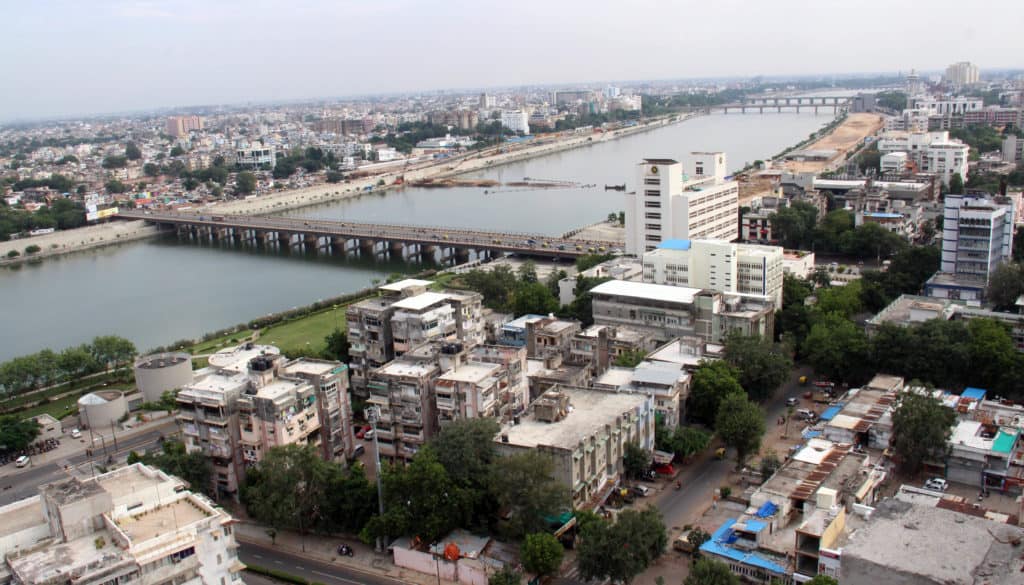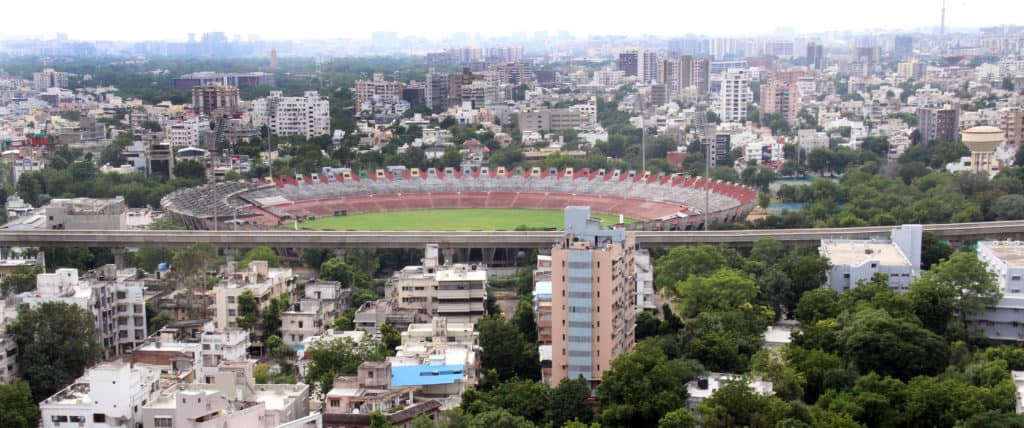Even as the COVID-19 contagion hits new peaks, Chief Minister Vijay Rupani is pushing his slogan of “Harega corona, jeetega Gujarat” (Corona will lose, Gujarat will win) to convey an ‘all is well’ picture and underline the fact that COVID-19 will not halt the state’s development. But what did come as a surprise was the recent announcement of the expansion of the civic limits of the municipal corporations of Ahmedabad, Vadodara, Rajkot, Surat, Gandhinagar and Bhavnagar.
The reason for this soon became obvious— elections are due in these six municipal corporations, all controlled by the ruling BJP in November-December. Poll preparations involving finalising the zones, accommodating new areas in various civic wards and drawing up voters’ lists would require at least two to three months.
This announcement kicked off these exercises, even as positive cases continued to spike on a daily basis, with Ahmedabad and Surat being particularly badly hit and the state as a whole having the highest percentage of Corona related deaths.
The expansion of municipal limits of major cities to include peripheral villages is a contentious issue, especially in Ahmedabad, which with its circuitous geography, is seeing a lot of unplanned construction activity on all its peripheries. It is also an example of how the state’s development paradigm seems to begin and end with indiscriminate real estate expansion.

Poor infrastructure
The decision to extend municipal corporation limits is like putting the cart before the horse. The best example of this are the areas under the Bopal and Ghuma Municipality, which have now been included in the Amdavad (Ahmedabad) Municipal Corporation limits.
Here, unplanned construction has been going on since the early 2000’s even though these areas are just not suited to handle the kind of expansion envisaged. For instance, they are prone to flooding with the first pounding of rain.
Requesting anonymity, a town planner knowledgable about the extension said, “Bopal’s population would have been around 5,000 in 2006 and it was already around 35,000 just five years later when it was brought under the Ahmedabad Urban Development Authority (AUDA) in 2011.”
“In Bopal-Ghuma, development took place without any organised town planning,” points out Prof Jignesh Mehta, Programme Chair, Masters of Urban Planning, at CEPT (Centre for Environment Planning and Technology) University. “The municipalities here were unable to provide basic infrastructure, like water supply, drainage, sewerage and roads”.
Also, two whole villages, Chiloda-Naroda gam and Kathwada, and parts of seven others, Santhal, Bilaspur, Aslali, Geratnagar, Khodiyar, Bilasiya and Ranasan, are now included in the AMC area.
When the Development Plan of 2011 proposed to develop it as a residential zone, it was not part of the AMC and remained under the AUDA, which is a planning authority and not a civic body. “Development charges were being collected which became a good way of raising resources for the AUDA,” said Mehta.
Also, not many residents in these areas want it to be made part of the AMC. “The rains in the last few weeks have resulted in potholed roads, waterlogging and heaps of waste are a common sight,” said Hitesh Patel, who has been living in the Bopal area for the last five years.
Worse, there is no one to go to. Hitesh says that they used to go to the panchayat office for complaints earlier and the staff was always there. They would listen to and solve the people’s problems. Now this office has been closed down and citizens do not know whom to approach.
Echoing his views is R P Sharma, who stays in the same area. Sharma added that “the area has witnessed a lot of development in the last 4 to 5 years and we are sceptical if this merger will be some magic wand. The situation in other areas merged earlier is pathetic.”
Real estate lobby at work
Ahmedabad’s extension outside the municipal limits was essentially decided by real estate developers, argues Jignesh Mehta. “That’s why we see a lot of horizontal growth on all sides of Ahmedabad, taking the citizens — and the heavy in-migration — away from downtown and all public transport and utilities,” Mehta points out.

Besides other facilities like drainage and sewerage, water quality in Ahmedabad’s peripheries is getting bad to worse with TDS (total dissolved solids) levels as high as 1,200 parts per million (ppm) to 1,500 ppm at some places. By WHO standards, acceptable TDS levels are 300 to 500 ppm.
When the 2011 Development Plan became operational in 2013-14, the AMC civic limits was 466 sq km until the new areas added 39 sq km to this, taking the total to 505 sq km.
The AMC is already faced with serious issues of basic infrastructure like roads, water and drainage even within its present jurisdiction. The inclusion of new areas would add to this burden, besides adding a population of over 1.25 lakh taking the city’s population to nearly 57 lakh people
The existing 48 municipal wards (192 councillors) were created based on the 2011 census while the new ones would be carved out only after the 2021 census, with each ward having a separate budget. Till then, the new areas will be made of the existing wards.
Officials say that in this situation of various needs, from upgrading the existing water and drainage systems to providing internal connections, the Corporation’s hands are more than full.
Even in areas like Vejalpur, Jodhpur, Ghandlodia, Gota, Tragad, Hebatpur and Chharodi, which were included in the civic limits in 2007, the AMC has been unable to complete water and sewerage projects. The residents here remain dependent on high TDS borewell water. No major road works have been initiated since these areas were merged.
Limited budget
Amul Bhatt, Chairman of the AMC’s Standing Committee, admitted that water and drainage works are still in progress in the areas merged in 2007. “With limited budget, priority is being given to town planning and roads,” Bhatt told Citizen Matters.
Civic officials also point out that the new areas will require major projects as the existing facilities created by the village panchayats are woefully inadequate. “Some of these areas still do not have proper drainage systems or adequate water supply,” an official said. Heaps of uncleared garbage in several places here point to the total lack of solid waste management system.
The AMC’s total budget for 2020-21 is Rs 8,907.32 crore, including Rs 5,014 crore for development works, with Rs 500 crore earmarked for laying drainage lines, water lines, roads and footpaths. Besides this, new water distribution stations, storm water drains and sewerage pumping stations have been proposed. This is for the existing areas.
Since the merger was announced at the end of the first quarter of the new financial year, the AMC will now have to spare funds from the existing resources to service the new areas. All this, when the AMC’s income has drastically fallen due to the COVID-19 crisis.
The AMC has divided the entire city into seven zones: Central, North, East, South, West, South west and North west, with each zone headed by a zonal officer.
Who gains?
City Engineer Hitesh Contractor told us that the AMC had started work in coordination with existing gram panchayats. Bopal-Ghuma Municipality has completed several projects and the AMC is adding new ones, he claims. He, however, says other villages on the circular SP Ring Road will need new and better infrastructure projects.
Leader of Opposition in AMC Dinesh Sharma from the Congress calls the merger a political gimmick. “This merger is not for the welfare of people but for the welfare of builders who give funds to the party,” alleged Sharma. “Land prices will increase. Even town planning schemes are prepared in sync with the interests of the builders”.
The one notable exception to this is probably Kathwada village on the eastern part of the city near Odhav where planning preceded development and a well designed road infrastructure was built. In fact, the residents here have protested the merger within AMC and have moved the Gujarat High Court.
The villagers say that the local gram panchayat has provided good facilities of road, water and drainage and they do not intend to be part of a densely populated Ahmedabad city.